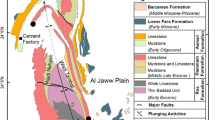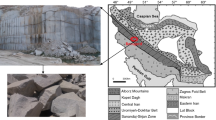Abstract
In this paper, ultrasonic P-wave is used to ascertain the mean grain diameter of heterogeneous D’Euville limestone. A previous model of P-wave is used to yield phase velocity (Vp) and the quality factor due to viscous squirt (Qps) in the ultrasonic band, for the limestone saturated with water. As the limestone has grain diameter (d) ranging from 400 to 1000 μm, we set the mean d to be 800, 600 and 400 μm in turn. Vp is fitted precisely as possible between the model and ultrasonic measurement. The emission frequency was 500 kHz. With the mean d of 800 μm, the model yields Qps agreeing with the measurement not very accurately and the average frequency (between emission and receiving) is inverted as 251 kHz (which is too low). With the mean d of 600 μm, the model yields Qps agreeing with the measurement surprisingly well and the average frequency is inverted as 355 kHz (which is very reasonable). With the mean d of 400 μm, neither Vp nor Qps fits well between the model and measurement and the average frequency is inverted as 631 kHz (which is unreasonable). It is concluded that the mean d of D’Euville limestone is 600 μm.
Highlights
Phase velocity and the quality factor of ultrasonic P-wave in water-saturated D’Euville limestone are accurately simulated
The mean grain diameter of heterogeneous D’Euville limestone is 600 μm
Phase velocity and the quality factor of the limestone are featured with novel spikes in the frequency domain







Similar content being viewed by others
Data Availability
The data from the model are available under doi https://doi.org/10.6084/m9.figshare.22199461 at https://figshare.com/s/d5e12fcda17f82c9791c.
Abbreviations
- \({a_{ij}}\) :
-
Asymmetric compressibility matrices
- b :
-
Aperture distance of COG
- d :
-
Diameter of grains
- D :
-
Depth of the rock unit
- f :
-
Frequency
- G :
-
Shear modulus of skeleton (dry rock)
- k :
-
Wavenumber
- \({K_d}\) :
-
Bulk modulus of skeleton (\({K_d}=\frac{1}{{{\beta _d}}}\))
- L :
-
Length of the rock unit
- Q p :
-
The total quality factor of P-wave
- Q ps :
-
The quality factor of P-wave due to viscous squirt
- Q s :
-
The total quality factor of S-wave
- V p :
-
Phase velocity of P-wave
- V s :
-
Phase velocity of S-wave
- \({\beta _d}\) :
-
Bulk compressibility of dry rock
- \({\beta _f}\) :
-
Bulk compressibility of fluid
- \({\beta _s}\) :
-
Compressibility of solid material
- \(\varphi\) :
-
Permeability angle
- \(\eta\) :
-
The total porosity (\(\eta ={\eta _1}+{\eta _2}\))
- \({\eta _1}\) :
-
The first porosity
- \({\eta _2}\) :
-
The second porosity
- \(\mu\) :
-
Fluid dynamic viscosity
- \(\nu\) :
-
Fluid kinematic viscosity (\(\nu =\frac{\mu }{{{\rho _f}}}\))
- \(\omega\) :
-
Angular frequency
- \(\gamma\) :
-
Squirt coefficient
- \(\rho\) :
-
The total density (\(\rho ={\rho _s}+\eta {\rho _f}\))
- \({\rho _f}\) :
-
Fluid density
- \({\rho _s}\) :
-
Skeleton density
References
Ablowitz M, Fokas A (1997) Complex variables: introduction and applications. Cambridge University Press, Cambridge
Auriault J, Boutin C (1994) Deformable porous media with double porosity III: Acoustics. Transp Porous Med 14:143–162
Auriault J, Boutin C, Geindreau C (2009) Homogenization of coupled phenomena in heterogeneous media. John Wiley and Sons, New York
Berryman J, Wang F (1995) The elastic coefficients of double-porosity models for fluid transport in jointed rock. J Geophys Res 100(B12):24611–24627
Biot M (1956a) Theory of propagation of elastic waves in a fluid-saturated porous solid I. Lower frequency range. J Acoust Soc Am 28:168–178
Biot M (1956b) Theory of propagation of elastic waves in a fluid-saturated porous solid II. Higher frequency range. J Acoust Soc Am 28:179–191
Boggs S (2009) Petrology of sedimentary rocks. Cambridge University Press, New York
Boutin C, Royer P (2015) On models of double porosity poroelastic media. Geophys J Int 203:1694–1725
Dvorkin J, Mavko G, Nur A (1995) Squirt flow in fully saturated rocks. Geophysics 60(1):97–107
Eslami J, Grgic D, Hoxha D (2010) Estimation of the damage of a porous limestone from continuous (P- and S-) wave velocity measurements under uniaxial loading and different hydrous conditions. Geophys J Int 183:1362–1375
Fine R, Millero F (1973) Compressibility of water as a function of temperature and pressure. J Chem Phys 59(10):5529–5536
Franklin J, Katsabanis T (1996) Measurement of blast fragmentation. CRC Press
Gassmann F (1951) Uber die Elasticität Poröser Medien [On the elasticity of porous media]. Vierteljahrsschrift der Naturforschenden Gesllschaft in Zürich 96:1–23
Green A, Zerna W (1954) Theoretical elasticity. Oxford University Press, Oxford
Gregory A (1976) Fluid saturation effects on dynamic elastic properties of sedimentary rocks. Geophysics 41:895–921
Jaeger J, Cook N, Zimmerman R (2007) Fundamentals of rock mechanics, 4th edn. Wiley-Blackwell, New York
Johnson D (2001) Theory of frequency dependent acoustics in patchy saturated porous media. J Acoust Soc Am 110:682–694
Jones T, Nur A (1983) Velocity and attenuation in sandstone at elevated temperatures and pressures. Geophys Res Lett 10:140–143
Kundu P (1990) Fluid mechanics. Academic Press, San Diego
Li G (2020) S-wave attenuation based on Stokes boundary layer. Geophys Prosp 68:910–917
Li G (2022) A new squirt coefficient to simulate P-wave attenuation. Geophy Prosp 70:815–827
Li G, Xie C (2021) Calculation of matrix permeability from velocity and attenuation of ultrasonic S-wave. J Geophys Eng 18:984–994
Li G, Mu Y, Xie C (2021) Unsymmetric compressibility matrix to model P-wave attenuation. Acta Geod Geophy 56:407–424
Li G, Miao Y, Li R (2022a) Ultrasonic S-wave to obtain shear modulus and matrix permeability of D’Euville limestone. Geofluids 2022a:5126760
Li G, Liu Y, Liu S (2022b) S-wave attenuation due to fluid acceleration. Pure Appl Geophy 179:1159–1172
Li G, Zhao H, Wang Q, Wang Z, Luo H (2022c) The mechanisms of S-wave attenuation in grainstones. J Geophys Eng 19:997–1004
Lucet N, Zinszner B (1992) Effects of heterogeneities and anisotropy on sonic and ultrasonic attenuation in rocks. Geophysics 57(8):1018–1026
Mavko G, Mukerji T, Dvorkin J (2009) The rock physics handbook: tools for seismic analysis of porous media, 2nd edn. Cambridge University Press, Cambridge
Mochizuki S (1982) Attenuation in partially saturated rocks. J Geophy Res 87:8598–8604
Murphy W, Winkler K, Kleinberg R (1984) Frame modulus reduction in sedimentary rocks: the effect of adsorption on grain contacts. Geophys Res Lett 11:805–808
O’Connell R, Budiansky B (1977) Viscoelastic properties of fluid saturated cracked solids. J Geophy Res 82:5719–5735
Øren P, Bakke S (2003) Reconstruction of Berea sandstone and pore-scale modelling of wettability effects. J Petro Sci Eng 39:177–199
Pride S, Berryman J (2003a) Linear dynamics of double porosity and dual-permeability materials I. governing equations and acoustic attenuation. Phys Rev E 68:036603
Pride S, Berryman J (2003b) Linear dynamics of double porosity and dual-permeability materials II. Fluid transport equations. Phys Rev E 68:036604
Pride S, Berryman J, Harris J (2004) Seismic attenuation due to wave-induced flow. J Geophy Res 109:B01201
Schlichting H (1968) Boundary layer theory, 6th edn. Springer, Berlin
Skempton A (1954) The pore pressure coefficients a and B. Geotechnique 4:143–147
Skinner B, Porter S (1999) The dynamic earth: an introduction to physical geology, 4th edn. John Wiley and Sons, New Yok
Smith M, Montgomery C (2015) Hydraulic fracturing. CRC Press
Toksöz M, Johnston D, Timur A (1979) Attenuation of seismic waves in dry and saturated rocks I. Laboratory measurements. Geophysics 44:681–690
Traska M (2014) Water transport properties in building materials: Traditional methods versus CT-based pore network analysis, M.S. thesis, Universiteit Gent
Walsh J (1965) The effect of cracks on the compressibility of rock. J Geophys Res 70(2):381–389
White J (1975) Computed seismic speeds and attenuation in rocks with partial gas saturation. Geophysics 40:224–232
Acknowledgements
The research was sponsored by National Natural Science Foundation of China (grant no. 42064006). We are deeply grateful to Editor-in-Chief (Gy?rgy Het?nyi), Editor and two anonymous reviewers for their positive comments and constructive suggestions.
Author information
Authors and Affiliations
Corresponding author
Ethics declarations
Conflict of interest
The authors have no conflicts of interest to declare.
Additional information
Publisher’s Note
Springer Nature remains neutral with regard to jurisdictional claims in published maps and institutional affiliations.
Rights and permissions
Springer Nature or its licensor (e.g. a society or other partner) holds exclusive rights to this article under a publishing agreement with the author(s) or other rightsholder(s); author self-archiving of the accepted manuscript version of this article is solely governed by the terms of such publishing agreement and applicable law.
About this article
Cite this article
Li, G., Li, X. & Wang, Y. Ultrasonic P-wave to ascertain the mean grain diameter of D’Euville limestone. Acta Geod Geophys 58, 451–463 (2023). https://doi.org/10.1007/s40328-023-00421-y
Received:
Accepted:
Published:
Issue Date:
DOI: https://doi.org/10.1007/s40328-023-00421-y




